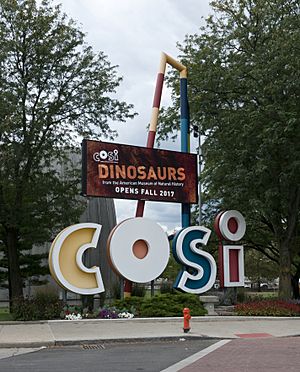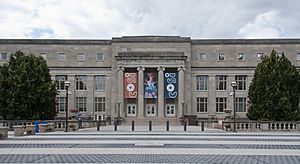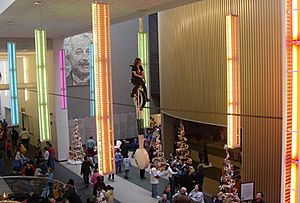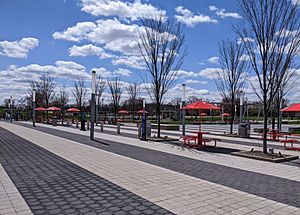COSI facts for kids
 |
|
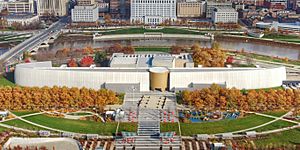
West facade and Dorrian Green
|
|
| Established | 1964 |
|---|---|
| Location | Columbus, Ohio |
| Type | Science museum |
| Founder | Sanford N. Hallock II |
| Public transit access | |
COSI (pronounced koh-sahy), which stands for the Center of Science and Industry, is a fun and educational science museum in Columbus, Ohio. It's a place where you can learn about science through hands-on activities.
COSI first opened its doors on March 29, 1964. For 35 years, it was located in a historic building called Memorial Hall. In 1999, COSI moved to a brand new, much larger building. This new building, designed by a Japanese architect named Arata Isozaki, is located right by the Scioto River in the Franklinton neighborhood. The museum has over 300 interactive exhibits for visitors to explore.
Before 2020, COSI had the biggest education program of any science museum in the United States. This included programs like COSI on Wheels, which traveled to schools across Ohio and the Midwest. They also offered local workshops, camps, and online video conferences. These programs reached hundreds of thousands of students each year.
COSI is a non-profit organization. This means it's supported by ticket sales, donations, and many volunteers. It also has nearly 20,000 member families. In 2008, Parent Magazine named COSI the #1 science center for families in the U.S. In 2020, USA Today also called it the #1 Science Museum in the country.
Contents
Explore COSI's Exhibit Areas
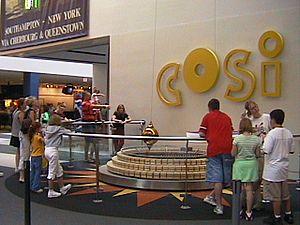
When COSI moved to its new building in 1999, it was designed with large, themed areas. Each area focuses on a different science topic. As of 2018, COSI has seven main exhibit areas. These include Ocean, Energy Explorers, Space, Progress, Gadgets, Life, and the American Museum of Natural History Dinosaur Gallery. The hallways between these areas also have many hands-on exhibits.
Ocean Exploration
You enter the Ocean exhibit through an underwater cave and a crashed shipwreck. One path leads to a submarine lab. Here, you can learn about ocean research, submersibles, and how water pressure works. The Lilypad Lab focuses on local wildlife found in drainage basins. Another path from the shipwreck leads to the Temple of Poseidon. This area has a huge statue of Poseidon with waterfalls and fountains. You can also explore the properties of water, like laminar flow and whirlpools.
Energy Explorers Adventure
Energy Explorers opened in 2013. In this exhibit, you pick an avatar character. Your avatar follows you through different zones of a town: the Home Zone, Transportation Zone, and Product Zone. You make choices at computer kiosks to balance how much energy you use with the cost.
Journey to Space
The Space exhibit has a copy of a space station pod you can tour. It also features a recreation of John Glenn's Friendship 7 spacecraft. You can try remote-operated vehicles and balance tests. Other experiments teach you about space flight, gravity, and landing rovers. The Space exhibit is now located on the Mezzanine level, leading to the Planetarium.
Progress Through Time
The Progress exhibit shows what a small town called Progress was like in two different years. First, you see it in 1898. This was when new things like electricity and cars were just starting. You can explore shops, homes, and restaurants from that time. Then, you turn a corner and enter the same town 64 years later, in 1962. Here, you see how much things changed. The town in 1962 has an appliance store, a working TV studio, and a gas station. This exhibit makes you think about how much progress has happened and what the future might look like.
Gadgets and Inventions
The Gadgets exhibit area is full of classic science experiments. You can try out pulleys, wind tunnels, plasma globes, and magnets. There's also the Gadgets Café. Here, families can sit down and choose quick science experiments from a menu. You can even take apart old phones, computers, and other electronics to see how they work.
Understanding Life
The Life exhibit explores what it means to be human. It has three parts: Mind, Body, and Spirit. The Mind area features optical illusions and an anechoic chamber, which is a super quiet room. The Body section has interactive stations where you can check your weight, flexibility, and heart rate. You can compare your results to others. The Spirit area talks about how different cultures understand birth and death. This exhibit also has Labs in Life, where OSU students and staff do real research.
Dinosaur Gallery
On November 19, 2017, COSI opened a permanent Dinosaur Gallery. This was done in partnership with the American Museum of Natural History. There is also a special gallery for traveling dinosaur exhibits. Together, these galleries cover a large area on the first floor.
Other Fun Features at COSI
COSI has a special "little kid space" designed for children up to first grade. It also has the National Geographic Giant Screen Theater, which is the biggest digital screen in Ohio. Outside, there's a Big Science Park. On November 22, 2014, COSI reopened its large Planetarium. It has a 60-foot dome and 220 seats, making it Ohio's largest planetarium. You can also find an exhibit about the History of COSI.
The building also has three big galleries for traveling exhibits and special events. There's a Dive Theater in the Ocean exhibit and the Galaxy Theater in Gallery 3. The Gadgets Stage hosts live science shows. When you get hungry, you can visit the Atomic Cafe. There's also a gift shop called Science2Go! and several meeting rooms. Some of these rooms are in parts of the former Central High School, which the new COSI building was built around.
COSI Science Festival
The COSI Science Festival is a huge event that celebrates science. It brings together COSI, Battelle, NASA, businesses, universities, and science leaders. The first festival took place from May 1–4, 2019. It included over a hundred community events across Central Ohio. The 2019 festival was one of the largest science events in Ohio's history. It reached 40,000 people.
In May 2020 and 2021, the festival was held online due to the COVID-19 pandemic. The digital festival in 2020 had nearly 120,000 online views. In 2021, it reached over 100,000 learners. In 2022, the festival returned to being mostly in-person.
The 2023 festival had record attendance. Over 11,000 visitors came to the community events. Another 33,000 attended the Big Science Celebration on the final day. Most attendees said the festival helped them learn about science and STEM careers. The COSI Science Festival is the largest STEAM (Science, Technology, Engineering, Arts, and Math) event in Ohio. The sixth COSI Science Festival was held from May 1-4, 2024.
COSI's History
COSI first opened on March 29, 1964. It was started by the Franklin County Historical Society. COSI is a founding member of the Science Museum Exhibit Collaborative (SMEC). It is also a long-time member of the Association of Science-Technology Centers (ASTC).
From 1964 until 1999, COSI was located in Memorial Hall. It closed at that location on September 6, 1999. Two months later, on November 6, 1999, it reopened at its new home on the Scioto riverfront. The new building is 320,000 square feet. It was designed by Japanese architect Arata Isozaki. The building looks like a "blimp" with curved concrete panels. From the Franklinton neighborhood, it looks futuristic. But from downtown Columbus, it blends in with the old Central High School building.
In 1972, COSI started the Camp-In program. This was an overnight program for Girl Scouts and Boy Scouts. This idea became popular in museums all over the country. Since 1964, nearly 30 million people have visited COSI or participated in its programs.
After moving to the new riverfront location, the museum faced financial challenges. The new building was expensive to maintain. Ticket sales were also lower than expected. In 2004, former NASA astronaut John Glenn led an effort to get a property tax approved. This tax would have helped fund COSI, and Franklin County residents would have received free admission. However, the tax was not approved. Because of this, part of COSI's building had to be closed.
Over the years, COSI has hosted many popular traveling exhibits. These include "Titanic: The Artifact Exhibition" and "Star Wars: Where Science Meets Imagination". COSI also created its own traveling exhibit called Lost Egypt: Ancient Secrets, Modern Science in 2009.
In January 2016, Dr. David Chesebrough, who was the president and CEO, announced his retirement. On November 10, 2016, Dr. Frederic Bertley was chosen as the new president and CEO of COSI. He started his role on January 1, 2017.
In 2016, a plan was approved to build an underground parking garage and a large green park next to COSI. This park, called Dorrian Green, was completed in 2018. It adds to the larger Scioto Peninsula green space along the river.
On September 16, 2016, COSI announced a partnership with the American Museum of Natural History (AMNH) in New York City. This partnership led to the creation of the permanent Dinosaur Exhibition Gallery. It also created a special gallery for AMNH traveling exhibits.
See also
- Imagination Station, formerly COSI Toledo, formerly affiliated with COSI Columbus
- List of museums in Ohio
- List of science centers


